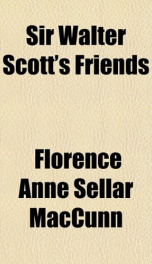sir walter scotts friends

Purchase of this book includes free trial access to www.million-books.com where you can read more than a million books for free. This is an OCR edition with typos. Excerpt from book: II. PARLIAMENT HOUSE FRIENDS GEORGE CRANSTOUN (LORD COREHOUSE) THOMAS THOMSON (DEPUTY-CLERK REGISTRAR) WILLIAM ERSKINE (LORD KINNEDDER) JANE ANNE CRANSTOUN (COUNTESS PURGSTALL) GEORGE CRANSTOUN (LORD COREHOUSE). The first twelve years of Scott's life fall within those years of growth and increasing prosperity which Creech describes so quaintly in the parallel paragraphs of his history of Edinburgh. By the time Scott was grown up the exodus towards the New Town was almost complete. Princes Street and George Street were at first long lines of dwelling- houses, too low and modest for the noble width of the street. Charlotte Square was indeed rising in classical symmetry, and the Adam Brothers had built a row of admirable houses on the slope commanding the view of the Forth, but the garden that lies now in front of Heriot Row was then but a rough slope where family washings were spread on the green. Not all at once could those who had ventured across the North Bridge resolve on the extravagance of a house with a main door. In the cross streetsFrederick and Hanover and Castlehouses were let in flats. The valley that lay between the old town and the new fitly symbolised the gulf between the society that had huddled in neighbourly squalor in the old courts and wynds and the generation that enjoyed unromantic comfort in the new streets. There was less eccentricity, less originality, less ceremony, less drinking; still, even in its new surroundings, Edinburgh society kept muchof its humorous and kindly individuality, while increased prosperity quickened ambition and high spirit in the younger generation. A stranger in the land, Lady Elliot, later Lady Minto, a keen observer and a woman of sound judgment, has recorded the impression made on her by the society of Edi...
Info about the book
Author:
Series:
Unknown
ASIN:
B0006BU3I2
Rating:
4/5 (3)Your rating:
0/5
Languge:
English
Users who have this book
Users who want this book
What readers are saying
What do you think? Write your own comment on this book!
write a commentif you like sir walter scotts friends try:
Other books by this author
Do you want to read a book that interests you? It’s EASY!
Create an account and send a request for reading to other users on the Webpage of the book!


